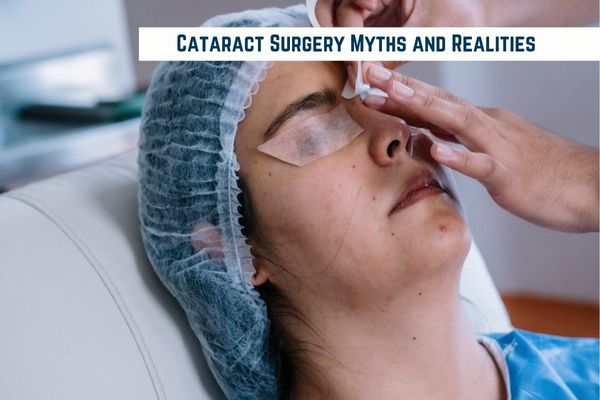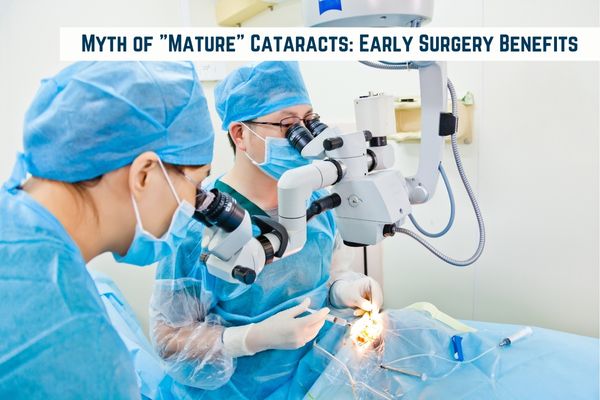Objective
The objective of this article is to debunk common myths surrounding cataract surgery and provide accurate information to help individuals make informed decisions about their eye health. It addresses misconceptions about the procedure’s safety, recovery time, effectiveness and who can benefit from it. By clarifying these myths, the article aims to educate patients about the real benefits of Cataract Removal Surgery, including the modern techniques and advanced intraocular lenses that can improve vision and quality of life. The goal is to promote early intervention and a correct understanding of cataract surgery.
Introduction

Cataracts are a common eye condition that affects many people, particularly as they age. However, despite the high success rate of Cataract Eye Surgery, there are still numerous myths and misconceptions about the procedure that can prevent people from seeking the treatment they need. In this article, we aim to debunk the most common myths about cataract surgery and provide readers with the facts they really need to know.
Myth: Cataract Surgery is Only for the Elderly
Fact: Cataract Surgery Can Be Performed on People of All Ages
While cataracts are more common in older adults, they can also affect younger individuals due to factors like genetics, diabetes, trauma, or prolonged use of certain medications. Even infants can be born with cataracts, known as congenital cataracts.
Myth: Cataract Surgery Is Dangerous and Risky
Fact: It’s a Safe and Routine Procedure
A common misconception about Cataract Surgery is that it’s a dangerous or high-risk procedure. However, modern Cataract Removal Surgery is incredibly safe, with a success rate of over 98%. Advancements in surgical techniques, such as Laser Eye Surgery for Cataracts, have made the procedure more precise and less invasive than ever before.
The procedure typically takes around 15 to 30 minutes and many patients experience significant improvements in their vision almost immediately. Cataract surgery has become a routine and effective way to restore vision, with minimal risks and complications.
Testimonials
“First Class Professional Care & Advice”
Myth: You Can’t Drive After Cataract Surgery for Weeks
Fact: Recovery is Fast and Many People Can Drive in a Few Days
A common belief is that after Cataract Surgery, patients will be unable to drive for weeks. However, most patients can resume driving just a few days after the procedure, once their vision has stabilized. It’s important to follow your surgeon’s advice, but for many, Cataract Surgery offers rapid recovery and the return to daily activities – including driving – can happen much sooner than expected.
Cataract surgery generally involves a quick recovery time, with many people able to return to their normal activities, including driving, within a week. It’s recommended to wait until you feel comfortable and confident with your vision before getting behind the wheel.
Myth: Cataract Surgery Always Results in Perfect Vision
Fact: Some People May Still Need Glasses After Surgery
While Cataract Removal Surgery significantly improves vision, it doesn’t always result in “perfect” vision for every patient. Some individuals may still need glasses after surgery for activities such as reading, driving at night or other close-up tasks. The need for glasses often depends on the type of intraocular lens (IOL) used during surgery.
Toric Lenses for Cataract Surgery can help correct astigmatism and improve vision at various distances, reducing the need for glasses. However, depending on the patient’s individual vision needs, some may still require corrective eyewear after the procedure.
Myth: Cataract Surgery is Painful
Fact: The Procedure is Painless and Quick
Many people fear Cataract Surgery because they believe it is a painful procedure. In reality, Cataract Removal Surgery is typically painless. Anesthesia is used to numb the eye, ensuring that patients do not feel discomfort during the procedure. Some patients might feel mild pressure during the surgery, but this is generally not painful.
Following Cataract Surgery, any discomfort is minimal and usually fades within a day or two. Modern surgical techniques, including Laser Eye Surgery for Cataracts, make the procedure even more comfortable and precise, offering a virtually pain-free experience.
Myth: Cataracts Can Be Treated with Eye Drops Instead of Surgery
Fact: Surgery is the Only Effective Treatment for Cataracts
A common misconception is that cataracts can be treated with eye drops or other non-surgical methods. Unfortunately, eye drops cannot cure or reverse cataracts. The only effective treatment for cataracts is Cataract Surgery, which involves removing the cloudy lens and replacing it with an artificial intraocular lens (IOL).
Cataract treatment through surgery is the only effective way to restore clear vision. Eye drops may help alleviate symptoms temporarily, but they do not address the underlying issue of cataract formation.
Myth: The Recovery Period for Cataract Surgery is Long
Fact: Most Patients Recover Quickly and Resume Normal Activities
One of the biggest myths about Cataract Surgery is that the recovery period is long and tedious. In reality, most patients experience a rapid recovery. While it may take a few weeks for the full healing process to complete, many patients notice significant improvements in their vision within the first few days after surgery.
The recovery period for cataract removal is generally quick, with most people able to return to daily activities, including work, within a few days. Your surgeon will provide instructions to ensure that the healing process goes smoothly.
Myth: Cataract Surgery Will Leave You with Glare or Halo Effects
Fact: Modern Techniques Minimize These Risks
Many people are concerned that after Cataract Surgery, they will experience glare or halo effects around lights, particularly at night. While this was a more common issue with older surgical techniques, modern advancements in Cataract Surgery, including Laser Eye Surgery for Cataracts, have greatly reduced these risks.
The use of advanced Toric lenses or premium IOLs in cataract surgery can help minimize glare and halos, offering better visual clarity in various lighting conditions. These newer lenses are designed to enhance contrast sensitivity and reduce optical distortions, improving the overall visual experience.

Myth: You Need to Wait Until Cataracts Are "Mature" Before Surgery
Fact: Early Intervention Can Lead to Better Results
It’s a common belief that cataracts need to reach an advanced or “mature” stage before surgery can be performed. However, waiting until cataracts are fully developed can lead to complications and a longer recovery period. In fact, early intervention is often the best approach for Cataract Treatment.
Cataract Surgery can be done at various stages of cataract development, even in the earlier stages, to improve quality of life and prevent further vision loss. Early Cataract Removal Surgery offers quicker recovery and better overall outcomes.
Myth: Cataract Surgery is Only for People with Severe Vision Loss
Fact: Surgery Can Be Performed at Various Stages of Cataract Development
Another misconception is that Cataract Surgery is only necessary for people with severe vision impairment. In reality, cataract treatment can be beneficial even in the early stages of cataract development, before vision loss becomes severe. Many patients opt for surgery early on to improve their quality of life and prevent further deterioration of their vision.
Cataract Surgery is effective even if the cataract is not fully mature. Addressing cataracts early allows patients to maintain better vision and avoid complications later on.
Client Speaks
“Extremely gentle, professional and informative, Could not wish for more “
Conclusion
There are many myths surrounding Cataract Surgery, but the facts are clear: Cataract Removal Surgery is a safe, effective procedure with a high success rate. Whether you are young or old, Cataract Surgery can help restore clear vision and improve your quality of life. Modern surgical techniques, including Laser Eye Surgery for Cataracts, have made the procedure more accessible and beneficial than ever before.
If you’re considering cataract surgery, consult with an experienced ophthalmologist to determine the best course of action for your eye health. Don’t let misconceptions keep you from experiencing the life-changing benefits of cataract treatment.
Author Bio:
Sussex Eye Laser Clinic, led by Consultant Ophthalmic Surgeon Mr. Mayank A. Nanavaty, offers advanced eye care solutions tailored to individual vision needs. With deep expertise in cornea- and lens-based refractive procedures, Mr. Nanavaty provides personalised vision correction solutions including implantable lenses, ipl for dry eyes and laser surgery. Each patient undergoes a comprehensive eye assessment to ensure treatments align with their visual goals. Using cutting-edge technology and a patient-focused approach, the clinic continues to lead in delivering high-quality refractive care.
